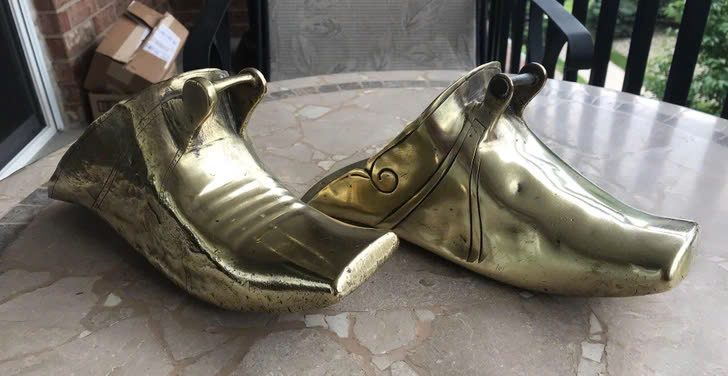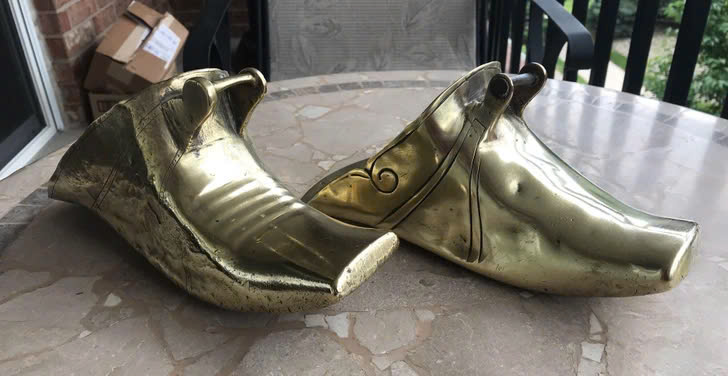“My dad bought these at a garage sale. They’re solid brass and open on the inside. Any ideas?”

Answer: They are fancy stirrups; devices attached to each side of a horse’s saddle in the form of a loop with a flat base to support the rider’s foot.
It started with a garage sale. Rows of mismatched antiques, curious trinkets, and forgotten heirlooms sat under the warm morning sun. My father, a man with an uncanny eye for unique finds, stopped in front of two gleaming objects resting quietly on a folding table. They were made of solid brass, shaped almost like shoes — elegant curves, delicate etchings, and an open interior. The seller called them fancy stirrups, but there was a story hidden in their golden shine.
At first glance, stirrups may seem like nothing more than a simple accessory for horseback riding — a place to rest your feet. But fancy stirrups, like the ones my father discovered, carry centuries of tradition, artistry, and cultural significance. They are not only functional but also a reflection of the rider’s status, skill, and heritage.
What Exactly Are Stirrups?
A stirrup is a device attached to each side of a horse’s saddle. It usually takes the form of a loop with a flat base where the rider’s foot rests. The purpose is simple but vital: stirrups provide balance, stability, and control. Without them, mounting a horse would be more challenging, and maintaining posture while riding could be exhausting — especially on long journeys or in combat.
While modern stirrups are often made from lightweight metals or synthetic materials, fancy stirrups have historically been crafted from brass, bronze, silver, or even gold. They were not just tools but also works of art.
A Short History of Stirrups
The stirrup’s story begins in ancient China, around the 4th century AD, when early versions were made of leather loops. By the 7th century, the innovation spread to Europe, transforming warfare and transportation. Cavalry units suddenly had greater stability, allowing for heavier armor and more precise weapon handling.
In regions like Spain, the Middle East, and parts of Asia, stirrups evolved into ornate masterpieces. They were engraved with patterns, inlaid with precious stones, and shaped into unique forms. The fancier the stirrup, the higher the status of its owner. Kings, nobles, and skilled warriors often had personalized designs that told stories of their victories and lineage.
The Functionality of Fancy Stirrups
At their core, stirrups provide three essential functions:
- Balance: Riders can stay centered in the saddle, even during sudden movements.
- Mounting Support: Makes getting on and off the horse easier, especially for those wearing heavy armor or elaborate clothing.
- Control: Allows riders to use their legs effectively to guide the horse, enhancing communication between human and animal.
Fancy stirrups deliver all these benefits while also adding an aesthetic edge. In parades, ceremonies, and formal competitions, their shine and craftsmanship reflect the rider’s prestige.
The Brass Beauties from the Garage Sale
The pair my father found were solid brass — heavy in the hand, with a subtle patina hinting at decades, maybe centuries, of history. Their curves were smooth, the edges worn slightly by use. The open interior design suggested they were made for comfort in warmer climates, allowing airflow to the rider’s feet.
A swirl-shaped embellishment adorned the side, purely decorative but beautifully balanced. This detail alone suggested they were not made for everyday farm work. No, these were ceremonial, possibly from a parade saddle or used in cultural events where the rider’s attire and gear were meant to dazzle.
Cultural Significance Around the World
In Mexico and South America, ornate stirrups are often part of charro and vaquero traditions. Riders wear vibrant costumes, and the horses are adorned with equally impressive tack. Brass or silver stirrups with intricate carvings are a symbol of pride.
In the Middle East, especially in countries with deep equestrian heritage like Oman or Saudi Arabia, stirrups can be silver-plated and engraved with Arabic calligraphy, serving as both functional gear and family heirlooms.
In Japan, abumi stirrups have a distinct, curved design, often lacquered or inlaid with gold. These were not only for riding but also an extension of a samurai’s identity.
Why Collect Fancy Stirrups?
For collectors, fancy stirrups are more than equestrian equipment — they’re history you can hold. Each pair tells a story about where it came from, who used it, and the cultural values of that time.
Some reasons people collect them include:
- Historical Value: Many are linked to specific eras or famous riders.
- Craftsmanship: Handmade designs showcase skills that are rare today.
- Decorative Appeal: Even outside the stable, they make stunning home décor pieces.
- Connection to Heritage: For families with equestrian roots, they are tangible links to the past.
Caring for Brass Stirrups
If you own a pair like my father’s, proper care ensures they remain beautiful for years:
- Cleaning: Use a soft cloth and a brass-safe cleaner. Avoid abrasive materials that scratch.
- Polishing: Brass naturally tarnishes over time. You can polish it to a bright shine or keep the patina for a vintage look.
- Storage: Keep in a dry place to prevent corrosion, preferably wrapped in soft fabric.
From the Saddle to the Living Room
Though these stirrups may never again hang from a saddle, they have found a new role. My father placed them on a wooden shelf near the fireplace, where sunlight catches the golden tones each afternoon. Visitors often ask, “What are those?” — and each time, it becomes an opportunity to share their history.
For me, they are more than just metal objects. They are a reminder of how something as simple as a riding aid can carry beauty, tradition, and human connection through centuries.
Final Thoughts
The world of horseback riding is full of functional tools, but some, like fancy stirrups, transcend utility. They are a bridge between practicality and art, between the past and the present. Whether they’re brass, silver, or another precious material, they stand as symbols of balance — both on the horse and in the stories they carry.
As I look at my father’s find, I realize these aren’t just stirrups. They are a silent echo of riders who came before us, carrying their journeys in every scratch and swirl.
“The smallest details often hold the richest stories — you just have to be willing to listen.”
Beta feature


